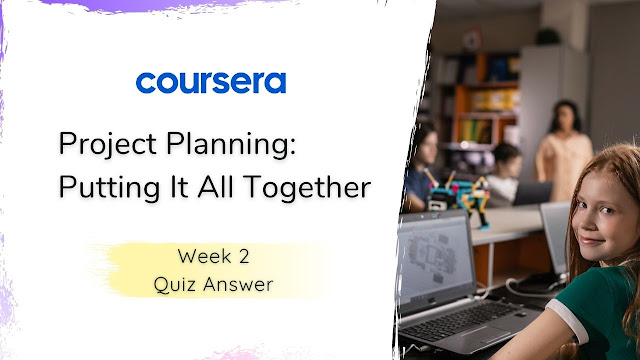Project Planning: Putting It All Together
Week 2 Quiz Answer
Weekly Challenge 2
Question 1)
When creating a project plan, you include important points within the schedule that indicate progress. Which project plan component does this represent?
- Tasks
- Milestones
- Time
- Relevant documentation
Question 2)
What tools can a project manager use to account for issues that may cause a project delay? Select all that apply.
- Gantt chart
- Sub-tasks
- Task buffer
- Project buffer
- float time
- capacity planning details
- critical path
- dependencies
Question 4)
Which examples below demonstrate a project manager asking an open-ended question? Select all that apply.
- What are the issues I need to be aware of regarding the current project timeline?
- What are the steps in your customer feedback review process and what factors do you include in your report of this review?
- Will you be able to have the transportation plan for the launch of the new truck series to dealerships ready by next week?
- Can you have this web design proposal completed and back to me by close of business Friday?
Question 5)
Tools like Gantt charts and Kanban boards help benefit team members in what three ways?
- They can translate project contracts like the statement of work (SOW) into number and dollar amounts.
- They can illustrate when they need to complete their individual tasks.
- They provide clear context about work project details.
- They can demonstrate how their individual tasks connect to other tasks in the project.
Question 6)
As a project manager, you’re the main supporter of your project plan. You explain to teammates why it benefits them to stay on top of the plan. You hope that this persuades the team to support the plan and update it regularly. What project plan best practice does this represent?
- Giving yourself time to plan
- Staying curious
- Recognizing and planning for the inevitable
- Championing your plan
Question 7)
Which of the following strategies could help a team meet a project deadline? Select all that apply.
- Rush through task planning
- Increase the team size
- Streamline tasks
- Eliminate unnecessary tasks
Question 8)
Fill in the blank: The _____ is the tendency to underestimate the amount of time it will take to complete a task.
- feedback fallacy
- planning fallacy
- anchoring bias
- confirmation bias
Question 9)
Imagine you’re a project manager creating a critical path. Your stakeholders request the earliest and latest start dates for each task. What is a strategy to make this time estimate?
- Create a list of dependencies.
- Use the forward pass or backward pass method.
- Review the project goals.
- Develop a RACI chart.
Question 10)
Fill in the blank: A Kanban board utilizes cards placed in columns to _____.
- set the timeline
- estimate the budget
- manage tasks
- organize documents
- is not relevant
- may vary depending on overlooked potential risks
- depends on stakeholder input
- shouldn’t change
- Set a budget
- Receive sponsor approval
- Get employees to respond positively in a survey
- Determine a new slogan
- Ask the right questions
- Negotiate effectively
- Build trust
- Practice patience
- Specifically who are completing what tasks
- A timeline of when the team will complete the tasks
- All project tasks
- Links to tasks in previously successful projects
- Ask yourself if the information in your plan is clear enough for stakeholders to understand
- Ask your team members to identify risks that will most likely occur and create plans to prevent or mitigate those risks
- Ask team members questions about their work to gain deeper insights into their tasks for the project
- Ask your team members daily if they are able to meet the deadlines they have for their tasks
- Prove competency by trying to resolve timeline concerns without input.
- Work quickly through the planning process to get the project started.
- Be thorough during the planning process.
- Escalate any timeline concerns to stakeholders.
- Add task buffers
- Add additional teammates
- Increase the budget
- Expand the project scope
- Make time estimates.
- Set dependencies.
- Create a network diagram.
- Consult your main customer.
- Kanban board
- Stakeholder power grid
- RACI chart
- Project charter
- It allows easy communication between teammates
- It has a clear breakdown of who’s responsible for what work
- It features the start and end dates of each task
- It’s a highly visual representation of the project’s tasks
- It shows when tasks are due for a project
- It displays comments from stakeholders
- The path of work from the start to the end of the project
- The tasks that can be performed in parallel
- Which non-essential tasks are not on the critical path
- Which skilled teammate can work on each task
- Daily review emails and messages between the stakeholders, project manager, and project team
- The project charter that defines the project and outlines project goal details
- The organization chart that depicts everyone who works in the company with their contact information
- RACI charts that define roles and responsibilities for individuals on a team
- marketing time
- vendor time
- inactive time
- stakeholder time
- The prediction of the amount of budget to be allocated to complete the project tasks.
- The total number of people involved in the project
- The estimated length of time it’ll take for the project team to complete project milestones
- The amount of work that people assigned to the project can reasonably complete in a set period of time
- Work breakdown structure (WBS)
- Gantt chart
- RACI chart
- Kanban board






2 Comments
Thanks you bro..
ReplyDeleteI really liked your blog article.
Nice Article ...
ReplyDelete